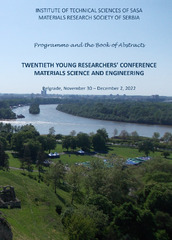| dc.contributor | Marković, Smilja | |
| dc.creator | Antanasković, Anja | |
| dc.creator | Lopičić, Zorica | |
| dc.creator | Šoštarić, Tatjana | |
| dc.creator | Milojković, Jelena | |
| dc.creator | Adamović, Vladimir | |
| dc.creator | Smiljanić, Danijela | |
| dc.creator | Milivojević, Milan | |
| dc.date.accessioned | 2023-10-12T10:43:18Z | |
| dc.date.available | 2023-10-12T10:43:18Z | |
| dc.date.issued | 2022 | |
| dc.identifier.isbn | 978-86-80321-37-0 | |
| dc.identifier.uri | https://ritnms.itnms.ac.rs/handle/123456789/885 | |
| dc.description.abstract | Annually, around 1.4 billion tonnes of food worldwide is classified as waste. This waste,
usually disposed at landfills, poses a serious threat to both the environment and human
health. With appropriate modifications, food waste can be converted into value-added
products for the removal of organic and inorganic contaminants from aqueous solutions. In
this study food waste (peach, cherry and plum stones) were modified with MgCl2 and
pyrolyzed to produce biochar, a multifunctional highly porous carbon rich material with
improved properties for phosphate (PO43-) removal. The samples were categorized using the
Fourier transform infra-red (FTIR-ATR) technique, point of zero charge (pHpzc) and pH
suspension (pHsus). The experimental sorption results revealed that the modified plum stone
biochar (PSB-M) has higher sorption capacities than other materials. Kinetic adsorption
experiments demonstrated that the pseudo-second-order model was the most suitable one for
PO43- adsorption on PSB-M. The production of such a sorbent can be affordable considering
that the raw material is regarded as waste. Therefore, the findings of this research can be a
foundation for the synthesis of an effective phosphate sorbent, whose properties and
maximum sorption capacity should be further researched. | sr |
| dc.language.iso | en | sr |
| dc.publisher | Belgrade : Institute of Technical Sciences of SASA | sr |
| dc.relation | info:eu-repo/grantAgreement/MESTD/inst-2020/200023/RS// | sr |
| dc.rights | openAccess | sr |
| dc.source | Twentieth Young Researchers Conference – Materials Science and Engineering | sr |
| dc.title | Modified food wastes as potential sorbents for phosphate removal | sr |
| dc.type | conferenceObject | sr |
| dc.rights.license | ARR | sr |
| dc.citation.epage | 76 | |
| dc.citation.spage | 76 | |
| dc.identifier.fulltext | http://ritnms.itnms.ac.rs/bitstream/id/1388/bitstream_1388.pdf | |
| dc.type.version | publishedVersion | sr |

